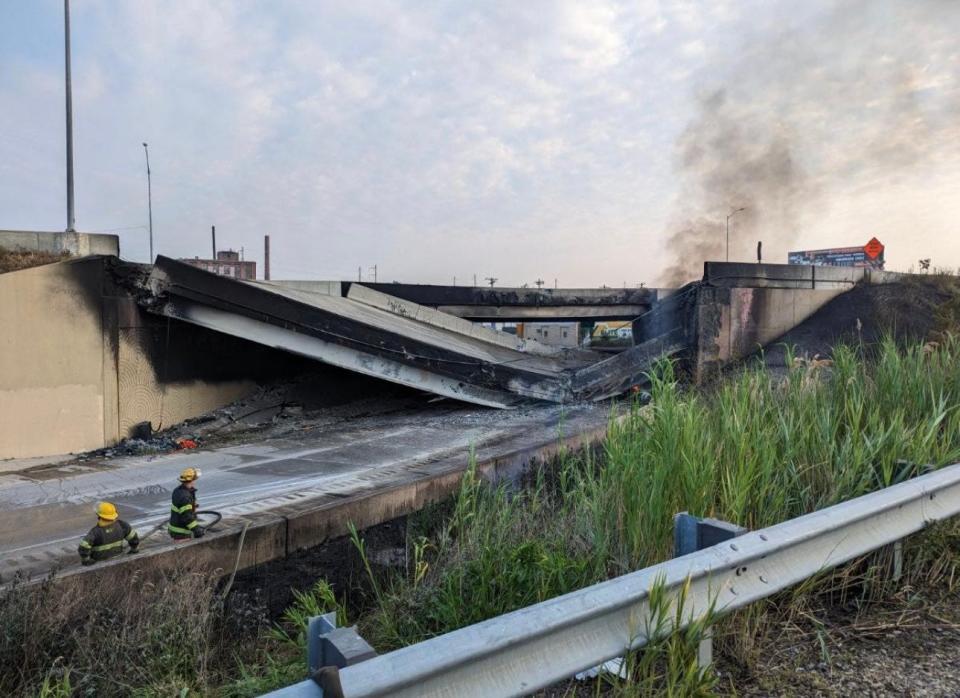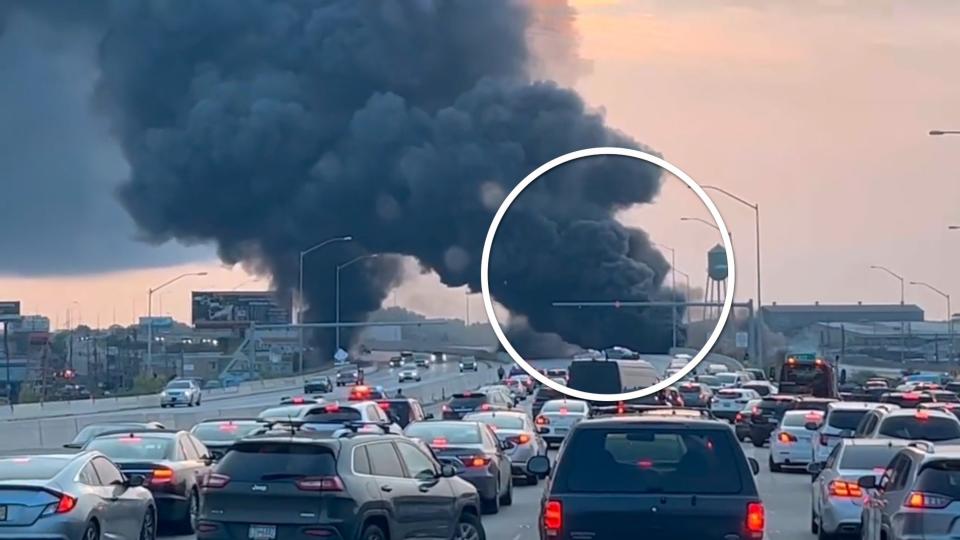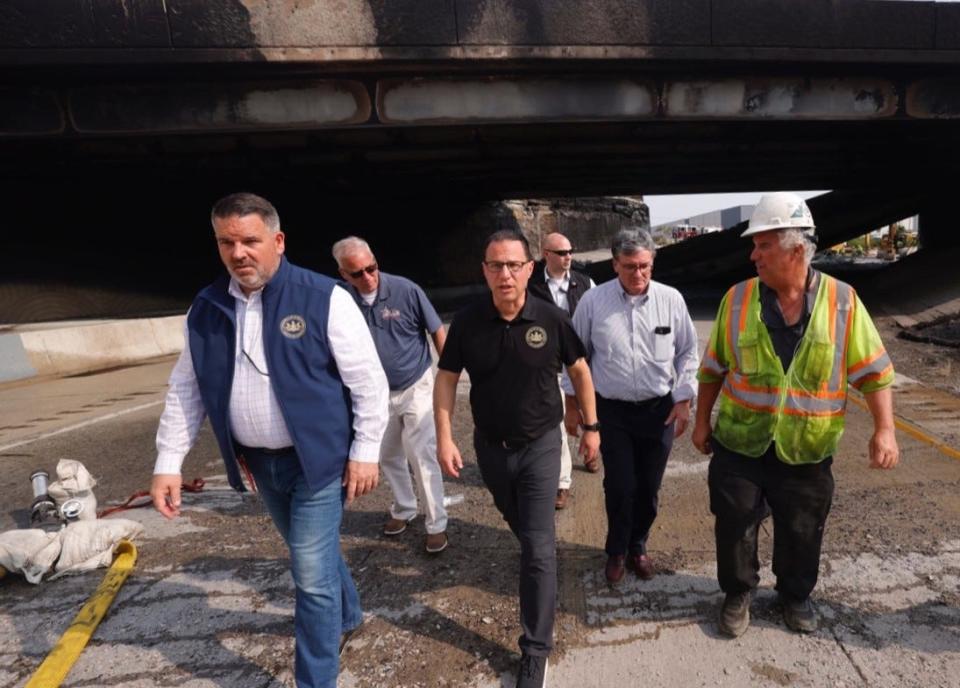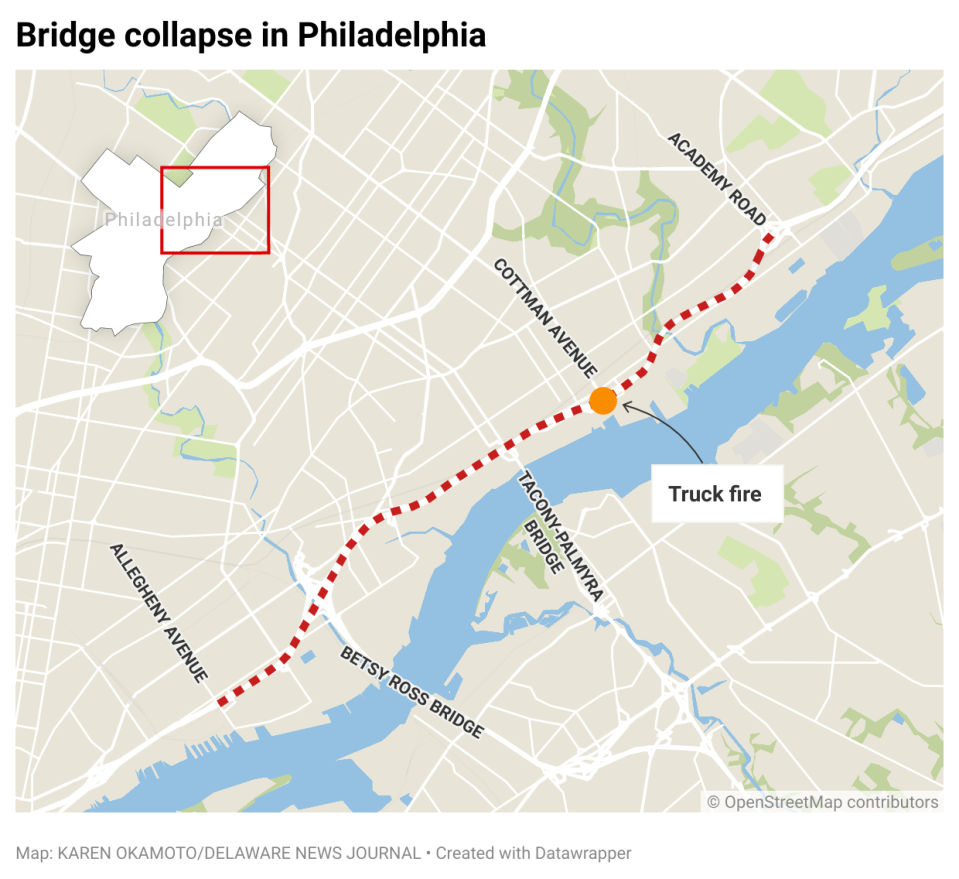A fiery physics lesson: Why the I-95 collapse in Philadelphia has no quick fix in sight
The collapse of an I-95 overpass Sunday morning in Philadelphia is a real-life physics lesson — the result of what happens when building materials come in contact with intense and prolonged heat.
Steel girders and concrete used in bridges can lose 50% of their strength at about 1,100 °F and 950 °F, respectively, according to Andrew W. Herrmann, past president of the American Society of Civil Engineers.
Sunday's fire, which ignited when a tractor-trailer hauling gasoline flipped on an I-95 off-ramp under the overpass, is estimated to have burned as hot as 2,000 °F, Hermann said.
"So with that type of a fire, we are way over what would cause damage to the bridge and actually lead to its collapse," he said.

The fire, which remains under investigation, caused a partial collapse of a portion of the interstate's northbound lanes and compromised the southbound lanes leading into Philadelphia. Pennsylvania State Police confirmed Monday night that a body was recovered from the scene.
The collapse shut down a seven-mile stretch of the interstate in both directions, impacting local traffic and cutting off a portion of the East Coast's primary highway. About 160,000 motorists travel along the impacted section every day.
Where is the I-95 collapse? Maps show where it happened and what detours to take
Why fire and steel don't mix
The introduction of steel in our highways and bridges has made them stronger, safer and faster to build. Steel, an alloy of iron and small amounts of carbon, also makes these structures more flexible, allowing them to be built in sites that are earthquake-prone or have high winds.
While these structures are usually stronger because of streel, they remain susceptible to such things as fires — especially fires that give off intense heat and burn for lengthy periods. It took the Philadelphia Fire Department about an hour to bring Sunday's blaze under control.

While buildings are protected from fire using sprinkler systems and other means, outdoor highways are not, Hermann said. That's because it would not be cost-effective.
Michael Chajes, a professor of civil and environmental engineering at the University of Delaware, pointed to factors such as freezing temperatures and other environmental exposures.
"But if you had something on a bridge and something happened, it's very possible it takes out your protective system," he said.
I-95 collapse: Body recovered; commuters face travel chaos after tanker hauling gas flipped
Damage from fires also vary.
For example, a tire fire in Philadelphia's Port Richmond area in 1996 did not bring down a section of I-95 like Sunday's blaze did, Chajes said. That fire did cause damage to the interstate that lead to a temporary closure, but drivers were back on the interstate as crews worked for months to reconstruct the roadway.
The current damage is estimated to leave the Philadelphia section of I-95 unusable for months.
"The difference in the two fires was that fire caused by tires is not going to be as intense and as hot as the fire caused by fuel. Similar to the (World) Trade Centers that collapsed, that was jet fuel," said Chajes, referencing the terror attacks in New York City on Sept. 11, 2001.
While many initially believed the skyscrapers came down after two hijacked Boeing 767s crashed into them, a report from the National Institute of Standards and Technology found the unusually large amount of jet fuel from the planes ignited multi-floor fires, which reached temperatures as high as 1,800 °F.
That significantly weakened the floors and columns with dislodged fireproofing to the point where floors sagged and pulled inward on the perimeter columns, leading to the buildings' collapse.
No quick fix for I-95 collapse
On Monday, Pennsylvania Gov. Josh Shapiro issued a disaster declaration, allowing the state and city to draw down federal funds to begin the reconstruction.
"I-95 is a critical roadway that supports our economy and plays an important role in folks’ everyday lives," Shapiro said.

While the declaration helps start rebuilding, experts say it will take months to fix the interstate, which still has to be fully inspected in order to find out the extent of the damage. Though the southbound span of the interstate's overpass did not collapse, Chajes suspects the lanes were compromised because of the fire's heat.
"That section didn't get as hot, but it got hot enough to damage the steel to the point where it probably needs to be replaced," he said.
Investigators must now find the extent of the damage and figure out if it needs to be repaired, strengthened or replaced.

Chajes expects the Philadelphia repairs to take months, but he said the speedy rebuilding of Atlanta's I-85 offers some hope I-95 might be fixed as quickly.
A massive fire in Atlanta in 2017 caused the collapse of an elevated portion of I-85, shutting down the roadway which was used by more than 250,000 people daily, according to the Greenville News. A contractor, working around the clock, was able to replace the roadway in about six weeks.
"Seeing that the Atlanta (project), which was a large section, was done in a few months tells me that you can do something that quickly," he said.
Has this happened before? Fiery I-95 collapse puts renewed focus on critical role of interstates in American life
But a lot still has to fall into place, Chajes said. This includes having the money, workforce and materials needed for a swift completion.
When I-495 over the Christina River closed during the summer of 2014 to make emergency repairs, construction workers needed certain rebar that was taking too long to arrive, Chajes said. Construction crews, he said, asked other worksites for the materials in order to finish the $45 million repairs.
"So some of those things come into play in repairing it," he said, "but I would say you're on the order of months."
Hermann, the past president of the American Society of Civil Engineers, said it would take time to figure out what happened and determine the extent of damage.
After that, officials will need to obtain steel from mills, where they will take it to a fabricator who will cut and weld the pieces together to make the beams that will then need to be delivered where crews can start working with them.
Laying out a slab of metal over the damaged area is a no-go, he said with a laugh. "It's almost 100 feet," Hermann said. "That's a big slab."
Other roadways, similar problems
Sunday's collapse is not the first such incident in the U.S. Each such calamity brings a set of impacts to local and commercial motorists who navigate the roadways.
The region has experienced previous structure damage, such as when a tire fire in Port Richmond resulted in severe structural damage to a portion of I-95 in 1996.
In 2013, a section of I-81 near Harrisburg closed in both directions, causing months of delays after a tanker truck fully loaded with diesel fuel overturned and exploded into flames, sending black smoke billowing into the sky.
This article originally appeared on Delaware News Journal: I-95 collapse in Philadelphia is a lesson in physics with no quick fix


